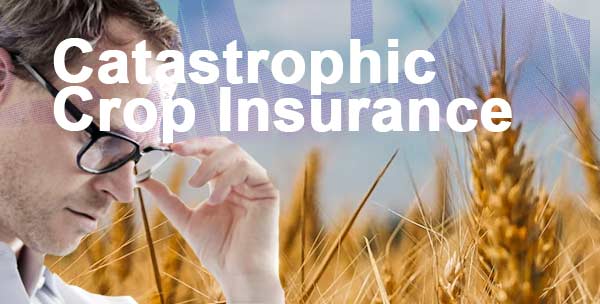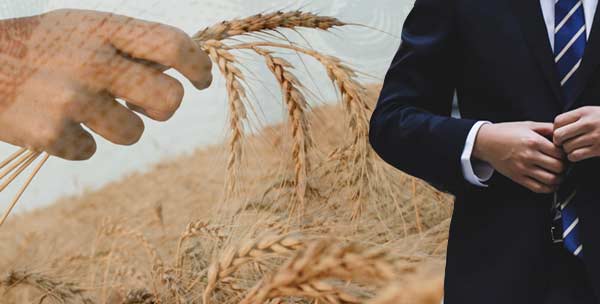
The US government's crop insurance program offers catastrophic crop insurance (CAT). If agricultural output losses surpass 50% of the typical historical yield, farmers are compensated under CAT coverage. Producers now have to pay a $300 administration fee per crop in place of a CAT insurance premium.
Farmers who participate in the catastrophic crop insurance program are protected from financial loss caused by unanticipated events. Farmers who might be in danger of losing their harvests due to natural disasters or other unforeseen circumstances beyond their control can benefit from this. The program is open to anything sold in the US regardless of the type of produce—fruit, vegetables, cereals, or livestock products—as long as it was cultivated in the nation and was intended for human use.
To aid farmers in recovering from extraordinarily bad weather catastrophes like hail or drought, the catastrophic crop insurance policy was created. For CAT coverage, farmers must pay $300 per year, per crop, and site. 60% of the total cost is split equally between the farmer and the US government. They will have to pay back this money plus interest if the harvest is spared.
As a last resort, farmers whose crops have been destroyed by a natural disaster turn to CAT. When there are no other options, it is used to assist farmers in their losses and recuperation after exceptionally severe weather disasters like hail or drought. CAT provides defense against crop failure brought on by extreme weather conditions that cause more damage than would be expected using conventional agricultural techniques during the growing season.
The optional CAT coverage, which is offered to all farmers, is typically chosen only by those who experienced a significant loss in their previous year's crop. Even though it can be obtained at any time during the growing season, the insurance company won't process claims without it. CAT insurance is frequently offered as a standalone policy, even though it can be combined with production or hail insurance. Do not mix crop insurance with CAT coverage; crop insurance covers the loss caused by drought or other natural disasters.

Catastrophic crop insurance can help a farmer who has suffered from extreme weather circumstances recover, but it is not free money. Restrictions apply to both the extent of the coverage and the amount that may be accessed. The farmer must pay a premium to be insured, and there are deadlines for making claims. The farmer must pay a premium to be covered. Farmers who own more valuable cropland will be required to pay higher rates than those who own less valuable land because the premium is based on the worth of the crop being insured. The insurance company may even insist that purchasing multiple policies to simultaneously cover different crops.
It must purchase various policies if it wants to cover multiple crops simultaneously. The amount of coverage supplied will depend on the price of each insurance premium. It can be very confusing due to limitations on the maximum amount of coverage that may be purchased and the number of years that may pass without a claim before the insurance company cancels the policy. The amount of coverage supplied will depend on the price of each insurance premium. It can be particularly challenging to comprehend due to limitations on the quantity of coverage that may be acquired and the number of years that may pass without a claim before the insurance provider ends the policy. Customers who purchase insurance pay a premium that covers coverage for losses caused by both human error, such as theft or vandalism, and natural calamities, like floods and droughts.
Catastrophic crop insurance (CAT) is provided by the Risk Management Agency (RMA) in two separate ways: subsidized insurance and subsidized reinsurance. Subsidized insurance helps farmers save money on insurance since it is actuarially sound and lowers their premium expenses. Therefore, if their crops fail due to severe climatic circumstances like high heat or drought, producers may be able to do so without going bankrupt. Farmers are drawn to subsidized insurance since it is actuarially sound and doesn't cause them to experience premium price surprises. Knowing exactly how much money is left over each year after paying the premium is another advantage of having subsidized insurance; this aids farmers in planning so they can make sure there is enough money left over for retirement or other expenses down the road when things start to get tight financially again, which happens frequently.
A farmer who purchases this type of policy against catastrophic losses from hail damage brought on by storms like tornadoes or hurricanes pays less per acre than a farmer who purchases only regular non-subsidized coverage, which typically costs about twice as much per acre due mainly to some basic elements that must be included into its provisions, such as additional amounts needed.
The term 'subsidized reinsurance' was created as a result of the government funding a portion of the cost for farmers who live in high-risk areas where severe storms and other extreme weather events are more likely to occur. When market prices fall inside of a specific range defined by Congress each year, the third sort of crop insurance, known as 'revenue loss coverage,' helps farmers recover losses brought on by low prices for their crops.
The government is responsible for paying the price of such a policy, and it utilizes the savings to fund other kinds of crop insurance. The fourth sort of crop insurance, referred to as 'supplemental coverage,' assists farmers in recovering losses when market prices fall below a predetermined threshold, much like revenue loss coverage does. These two plans are distinct from one another because supplemental insurance only helps farmers with loss recovery after they have paid their deductible and the initial 10% of the cost of any insured crops.
The 'noninsured crop disaster support program,' the fifth type of crop insurance, provides help to farmers in areas vulnerable to calamities like floods and droughts. Farmers don't have to pay any upfront fees to be reimbursed for their losses because the government pays the premiums for this kind of insurance. When market prices fall below a set threshold, farmers can recover losses with the aid of the sixth type of crop insurance, known as 'revenue diversion.' In contrast to the supplemental insurance coverage previously described, this policy pays out when yield levels fall below regional averages.
Farmers must pay a $300 yearly charge to have CAT protection. There is a yearly fee for each area where the farmer grows crops. Farmers may also choose to invest more money to concurrently cover one or more locations.
CAT policies are provided by insurance companies with agreements with the Federal Crop Insurance Corporation to provide farmers with financial security if their crops fail due to natural disasters like floods, tornadoes, hurricanes, and other weather-related events that harm their land or other property (FCIC). The cost of the policy is influenced by the type of farm being covered, whether it is irrigated or not, and the average production. The FCIC offers both simple and complex policy types. Basic insurance does cover losses resulting from weather-related events that cause crop failure or damage, but it does not cover losses resulting from losses caused by bugs or diseases.
The full coverage includes protection against all types of losses, including those brought by pests or illnesses. In addition to these two types of coverage, farmers may choose to obtain additional insurance from private companies to protect their crops from specific risks like drought or flood. If farmers choose to purchase crop insurance, they must pay an annual premium based on their average output over the previous three years. On the FCIC website, farmers may find out how much insurance they need and how much it would cost.